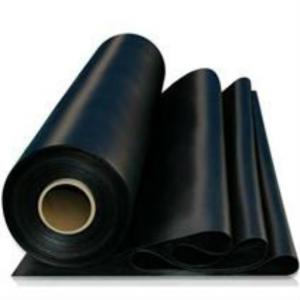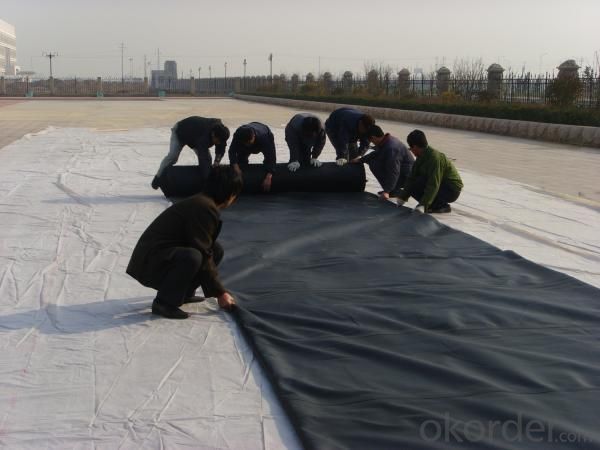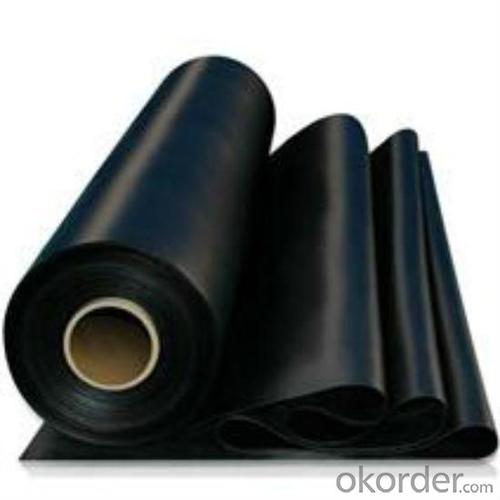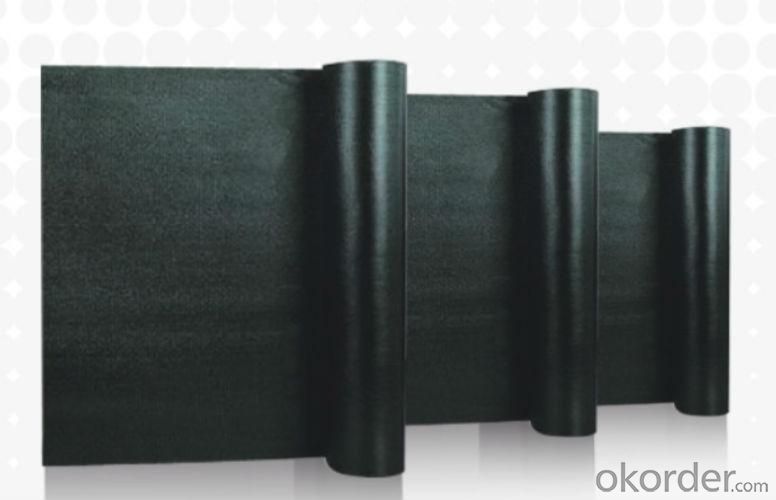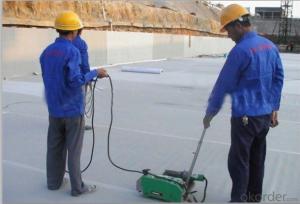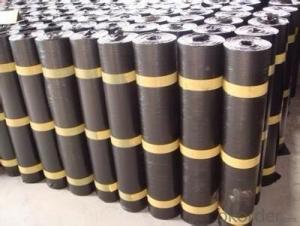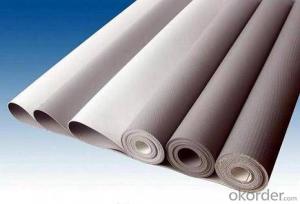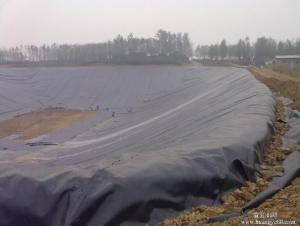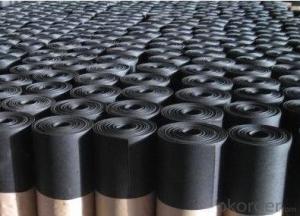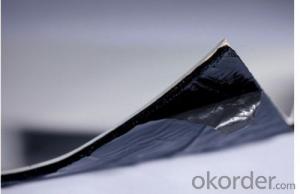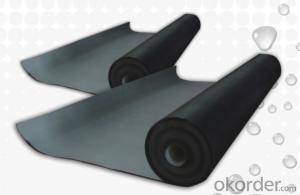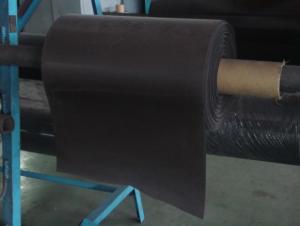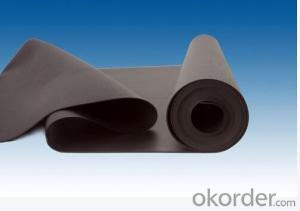EPDM Waterproof Membrane For Roofing
- Loading Port:
- Qingdao, China
- Payment Terms:
- TT or LC
- Min Order Qty:
- 2000 M2 m²
- Supply Capability:
- Above 10000000M2 Per Year m²/month
OKorder Service Pledge
OKorder Financial Service
You Might Also Like
Detailed Specification for EPDM Waterproof Membrane:
|
Type |
EPDM Waterproofing Membrane | |||
|
Material |
EPDM Rubber | |||
|
Thickness |
1.0mm |
1.2mm |
1.5mm |
2.0mm |
|
Size |
1.2m(width) * 20m(length)/roll, Weldale could 4m width | |||
|
Type |
Vulcanized & Weldable | |||
|
Pattern |
Non-reinforced(homogeneous) | |||
|
Packing |
24sqm--80sqm/roll, with plastic bag | |||
|
Color |
Black | |||
|
Application |
Roof, basement, pond, Lake, steel structure roof, swimming pool, underground, tunnel, etc | |||
Product Features of EPDM Waterproofing Membrane:
1. the excellent anti-aging, in the long term light, humidity, cold use of the natural
environment, small changes in physical properties, used in the temperature:
From -50 degree Celsius to +80degree Celsious.
2.with outstanding ozone resistance, resistance to ultraviolet and atmospheric corrosion
of many chemical corrosive substances.
3. high tensile strength, high elongation, high flexibility, capable of sustaining
a puncture of hard material, good anti-crack, high adaptability of the grass roots'
contraction and the crack and deformation, and give full play to extend the
performance, playing the role of waterproofing.
4.long lifetime, high durability can achieve more than 25 years.
5.the cold construction operation, no environment pollution and simple operation.
Application Pictures of EPDM Waterproof Membrane:
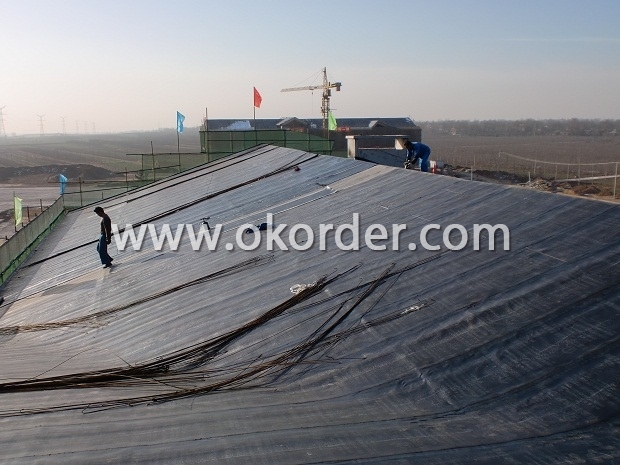
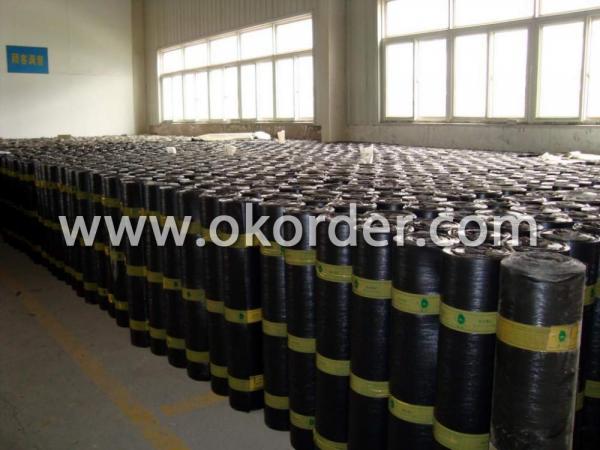
- Q: Can a waterproofing membrane be used in bathrooms?
- Indeed, bathrooms can benefit greatly from the utilization of a waterproofing membrane. It is strongly advised to employ such a membrane in bathrooms as a preventive measure against water-related harm and leakage. Typically, this membrane is applied to both the walls and floors, establishing a protective barrier that inhibits water infiltration, subsequently averting structural deterioration or the proliferation of mold. This is particularly crucial in areas of heightened water exposure, such as showers and the vicinity of bathtubs. These waterproofing membranes are engineered to endure moisture and offer enduring safeguarding, thereby assuring the soundness of the bathroom and prolonging its longevity.
- Q: Can a waterproofing membrane be used in mining or excavation projects?
- Indeed, mining or excavation projects can make use of a waterproofing membrane. Such membranes are specifically crafted to thwart the infiltration of water and other liquids, making them a perfect remedy for regions susceptible to water intrusion, such as mines or excavations. Typically, these membranes are fashioned from resilient substances like rubber or bitumen, and they are affixed to the walls, floors, or roofs of these structures to establish an impervious barricade. By employing a waterproofing membrane, mining and excavation projects can diminish the likelihood of water harm, safeguard equipment and infrastructure, and guarantee a secure working environment for laborers.
- Q: Can a waterproofing membrane be used on cinder block surfaces?
- Yes, a waterproofing membrane can be used on cinder block surfaces. It provides an effective barrier against water penetration and helps to protect the cinder block from moisture-related damage.
- Q: Can a waterproofing membrane be used for a bathroom?
- A bathroom can indeed utilize a waterproofing membrane, and it is strongly advised to incorporate one in order to avert water damage and leakage. This membrane functions as a barricade, effectively obstructing the infiltration of water into the underlying framework, like the walls or floors. This is especially crucial in zones with regular water exposure, such as showers and bathtubs. By installing a waterproofing membrane, you can guarantee a dry bathroom environment, thereby averting any potential harm to the structure and the formation of mold and mildew.
- Q: What materials are commonly used for waterproofing membranes?
- Commonly used materials for waterproofing membranes include bitumen, modified bitumen, polyvinyl chloride (PVC), ethylene propylene diene monomer (EPDM), thermoplastic polyolefin (TPO), and chlorinated polyethylene (CPE).
- Q: Can a waterproofing membrane be used for a warehouse?
- Certainly, a warehouse can utilize a waterproofing membrane. This particular product is specifically designed to prevent the infiltration of water and safeguard structures from moisture-related harm. It can be applied to various surfaces, including concrete, metal, and wood, thereby making it suitable for warehouses constructed from diverse materials. By implementing a waterproofing membrane in a warehouse, several advantages can be obtained. Primarily, it aids in the prevention of water infiltration, which is especially vital in regions with heavy precipitation or in close proximity to bodies of water. By obstructing water from permeating the warehouse, it serves as a safeguard for the contents within, shielding them from water-induced damage such as rust, mold, and decay. Furthermore, a waterproofing membrane can enhance the overall structural integrity of the warehouse. Moisture has the potential to weaken the construction materials employed, leading to potential structural problems over time. By establishing a barrier against water, a waterproofing membrane can significantly prolong the lifespan of the warehouse and minimize the necessity for costly repairs. Moreover, a waterproofing membrane can also contribute to a healthier indoor environment within the warehouse. By thwarting water infiltration, it diminishes the risk of mold growth, which can be detrimental to air quality and the well-being of occupants. This is especially crucial if the warehouse stores delicate goods or if workers spend substantial amounts of time within the facility. To summarize, a warehouse can indeed incorporate a waterproofing membrane. It provides protection against water infiltration, enhances structural integrity, and contributes to a healthier indoor environment. The selection of an appropriate waterproofing membrane and ensuring its proper installation are critical in guaranteeing optimal performance and long-lasting protection for the warehouse.
- Q: Can a waterproofing membrane be used on tile surfaces?
- Yes, a waterproofing membrane can be used on tile surfaces. It helps to provide an additional layer of protection against water damage and helps to prevent water penetration through the tile surface and grout lines.
- Q: Can a waterproofing membrane be used on tunnels with soundproofing systems?
- Tunnels with soundproofing systems can benefit from the use of a waterproofing membrane. It is common practice to integrate waterproofing membranes with soundproofing systems in tunnels. This is because tunnels are prone to water infiltration, which can cause structural damage and impact the performance of the soundproofing system. By applying a waterproofing membrane, the tunnel can be shielded from water intrusion, ensuring the durability and efficacy of the soundproofing system. Moreover, the waterproofing membrane aids in maintaining a dry and comfortable environment in the tunnel, which is essential for the efficient operation of the soundproofing system. Therefore, combining a waterproofing membrane with a soundproofing system is highly recommended in tunnels to provide both water protection and sound insulation.
- Q: Can a waterproofing membrane be used for swimming pools?
- Yes, a waterproofing membrane can be used for swimming pools. Waterproofing membranes are commonly used in swimming pool construction and renovation projects to prevent water leakage and ensure the pool remains watertight. These membranes are specifically designed to withstand constant exposure to water and provide a durable and long-lasting solution for swimming pools.
- Q: Can a waterproofing membrane be used for pond or pool applications?
- Certainly! A waterproofing membrane is suitable for both pond and pool applications. Its main purpose is to create a barrier that prevents water from penetrating, making it an excellent choice for sealing ponds and pools. These membranes are typically made from synthetic materials like PVC, EPDM, or TPO, all of which have high resistance to water and UV rays. They come in different thicknesses and can be tailored to fit the specific dimensions of the pond or pool. Moreover, waterproofing membranes are incredibly durable and flexible, allowing them to withstand continuous exposure to water and the movement of the underlying substrate. In summary, utilizing a waterproofing membrane for pond or pool applications helps avoid leaks, extends the lifespan of the structure, and guarantees a safe and enjoyable water environment.
1. Manufacturer Overview
| Location | Hebei, China |
| Year Established | 2003 |
| Annual Output Value | Above US$ 10 Million |
| Main Markets | Europe; North America; Africa; Asia |
| Company Certifications | ISO 9001 |
2. Manufacturer Certificates
| a) Certification Name | |
| Range | |
| Reference | |
| Validity Period |
3. Manufacturer Capability
| a) Trade Capacity | |
| Nearest Port | Tianjin; Qingdao |
| Export Percentage | 50% - 100% |
| No.of Employees in Trade Department | 6- 10 people |
| Language Spoken: | English; Chinese |
| b) Factory Information | |
| Factory Size: | 100000 Square meters |
| No. of Production Lines | Above 5 |
| Contract Manufacturing | OEM Service Offered; Design Service Offered |
| Product Price Range | |
Send your message to us
EPDM Waterproof Membrane For Roofing
- Loading Port:
- Qingdao, China
- Payment Terms:
- TT or LC
- Min Order Qty:
- 2000 M2 m²
- Supply Capability:
- Above 10000000M2 Per Year m²/month
OKorder Service Pledge
OKorder Financial Service
Similar products
Hot products
Hot Searches
Related keywords
